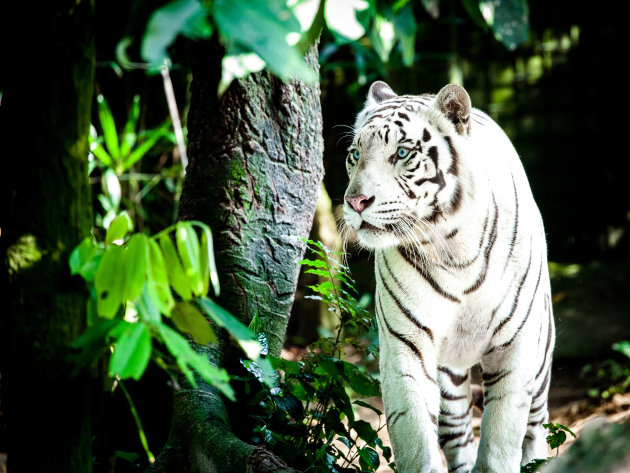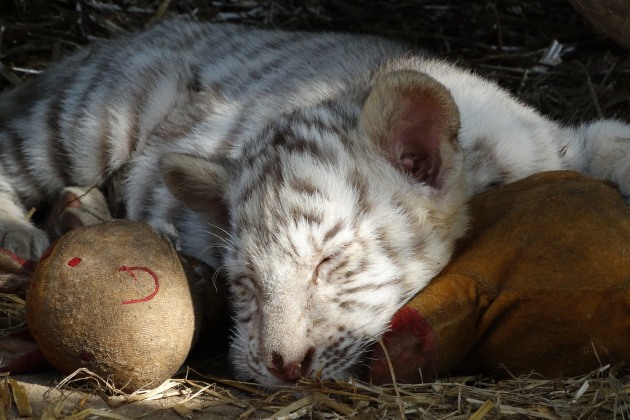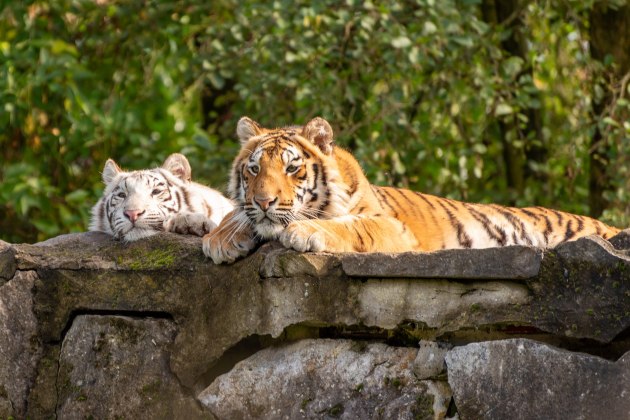



White tigers are a rare subspecies, and it’s believed that a white tiger hasn’t been seen in the wild for around 50 years, making them endangered. When they are in the wild they would be found throughout India. Although, today you’re more likely to find a white tiger in a zoo or sanctuary around the world. The white tiger originates from Bengal tigers but has a unique difference of colour.
These tigers are also commonly referred to as white Bengal tigers, very alike to a Bengal tiger, but lacking the orange hue. The whiteness to their fur is achieved by a genetic defect which results in white tigers losing a pigment called pheomelanin, which gives Bengal tigers the orange colour in their fur. The lack of this pigment gives white tigers the unusual and unique white colour.
Their survival in the wild has become a battle due to trophy hunting and capture for the expense of exotic wildlife trade. Another factor is how rare the white tiger is - the colouration is dependent on a defective, recessive gene which is passed to them from their parents. For example, another white tiger can only be created if both parents carry the recessive gene to achieve white colouration.
Trophy hunting and habitat loss are just a few examples of why the white tiger has become endangered, and sadly led to extinction in the wild. It’s believed the last surviving white tiger was sadly killed in the 1950s leaving behind any trace of the white tiger remaining in the wild. Today the only surviving white tiger are in zoos or sanctuaries.
The white tigers that remain today are thanks to a solitary male tiger that was captured in 1951. Efforts to restore the white tiger were done so by deliberately interbreeding to maintain the tiger’s white colouration. This is the only way to make sure the white tiger succeeds, but it does come with health complications. As scientists identified these problems with interbreeding, work has begun to try and cross-breed pairs of Bengal tigers, with each one holding the gene that creates the white tiger. It’s believed the probability rate would be a 25 per cent chance of a pregnancy resulting in a white tiger. This way will help increase the population of white tigers more healthily.
The current population is currently around 200, with them all remaining in captivity.
The white tiger is listed as endangered under ICUN (International Union for Conservation of Nature) and is severely threatened, therefore the only remaining species are in captivity. The white tiger isn’t the only tiger endangered as Records show that around 100,000 tigers were found in Asia during the beginning of the 1900s - today is a different story with no more than 8,000 remaining in the wild. It’s estimated that 2,000 of this number are Bengal tigers, white tigers are not included as they remain in captivity.
|
Kingdom: |
Animalia |
|
Phylum: |
Chordata |
|
Class: |
Mammalia |
|
Order: |
Carnivora |
|
Genus: |
Panthera |
|
Scientific name: |
Panthera tigris Tigris |
When a white tiger is in the wild its preferred habitat is in the Asian and Indian subcontinent, just like the Bengal tiger. A white tiger's habitat would exist of tropical jungles, mangrove swamps and grasslands, their habitat would also include plenty of freshwater nearby. They also require cover to be able to stay hidden as well as plenty of trees. In their natural habitat, a white tiger has a large territory, ranging from 10 to 30 square miles.
Going back to the time when white tigers roamed freely in their habitat in the Asian and Indian subcontinent, they would often find it hard to hunt. Their white colouration made it difficult for them to successfully hunt for food, making most of their hunts unsuccessful.
White tiger’s don’t have any natural predators within or around their natural habitat, however, humans are the biggest threat to them due to trophy hunting, traditional medicines and the exotic pet trade.
Another big risk is the fact that Bengal tigers are also declining which makes the chances of a white tiger being reproduced less and less every day.
A white tiger is just like the Bengal tiger in the same sense that they spend most of the day sleeping, whilst hunting for food during the nighttime. Their diet consists of large carnivores such as deer, wild boar, cattle and goat. Although, when white tigers are in zoos or sanctuaries they are usually fed chicken, horse meat, and sometimes kangaroo meat too.
Did you know that when white tigers are in the wild they can run up to 60 miles per hour? They use this to their advantage when tracking down their prey, whilst also using their weight to knock prey down.
White tigers have been known to have several health problems due to their need to be interbred. Problems can include spinal, immune deficiencies, problems with their lung development and cleft palettes. The ZAA (Zoo Aquarium Association) believe that white tigers face another problem due to their lack of skin pigmentation. It’s believed that in the Southern Hemisphere they would be at a higher risk of skin conditions related to UV damage.
In 2011 the Association of Zoos and Aquarium in the USA banned the breeding of white tigers to zoos who are a member of the association.

Life begins as a cub and a female white tiger can give birth to up to three cubs at a time. For two months the cubs suckle milk from their mother, shortly after they start to be weaned. At 18 months of age, the cubs start to be introduced to hunt on their own, although they still stay close to their mother until they reach two years of age. Once fully matured white tigers are very territorial, they mark their spot with urine or by clawing marks on trees. These spots are only for them and no other tiger can enter.
Did you know that a white tigers average lifespan is between 12 and 20 years? Although, this is dependent on them being in captivity.

The white tiger, just like other tiger species like to live alone and are a solitary animal. They live like this as it would make it easier for them to hunt in the wild, as they usually sneak up on their prey. Although, during mating season male white tigers territories would overlap with females to find a partner to mate with.
White tigers have been known to have excellent hearing and eyesight which makes hunting in the dark a lot easier for them. White tigers aren’t nocturnal, however, they would have done most of their hunting at night for a more successful outcome.
All tigers are one of the few cats that like to swim and are good swimmers. Most tigers don’t fully submerge in water, however, white tigers have been known to.
White tigers are stronger and much more muscular than any other tiger species, therefore they are much stronger.
Humans have played a part in the interbreeding of white tigers since they were brought into captivity, although this has been morally questioned as sometimes this can be carried out for profit. Flashback 50 years when white tigers were roaming the wild, humans played a big part in them disappearing by hunting them, making them lose lots of their natural habitat and eventually would end in them disappearing from the wild.
Unfortunately, it doesn’t stop here as Bengal tigers have been known to enter human environments more often which results in them being killed. However, due to the declining numbers, it was made illegal to shoot them.
In the year 1915, a white tiger cub was captured and was held captive for five years, until it eventually died. It’s believed the white tiger was stuffed afterwards and was given to King George V of England as a gift.
Between the years of 1920 to 1930, it’s estimated that 15 white tigers were killed in Bihar, India.
The most famous white tiger dates back to 1951, the male white tiger was named Mohan and was found in the wild in India. It’s believed the tiger was captured and kept in Maharajah’s palace in the courtyard. It was later bred with female tigers to help produce more white tigers. Mohan lived for 19 years and is believed to be the source of all the 200 white tigers that remaining in the world today.
Learning all about the animal kingdom is fun and exciting for children and tigers are no exception. Let them explore the wonderful world of tigers including the ever so rare white tiger with the help of some of our wonderful resources. They’ve all been made by our range of experienced teachers, so you can rest assured that they are all in line with the national curriculum aims and targets. Using our resources is a great way to ease teacher workload too, so you can spend more time on what matters the most -- educating your class. From colouring, sheets to PowerPoints, you’ll be sure to find an engaging resource that’ll help mix up your lessons and transform your teaching.